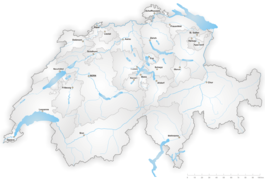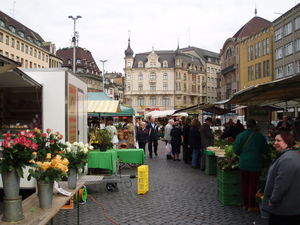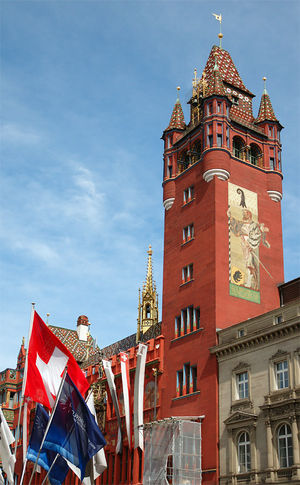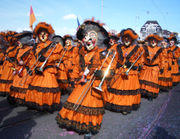Basel
2007 Schools Wikipedia Selection. Related subjects: European Geography
| Basel | |
|---|---|
 |
|
| Canton | Basel-Stadt |
| District | n.a. |
| Coordinates | |
| Population | 166120 ( December 2002) |
| Area | 22.75 km² |
| Elevation | 260 m |
| Postal code | 4000 |
| Mayor | Ralph Lewin ( Pres. of Cantonal exec.) |
| Website | www.basel.ch |
Basel (British English traditionally: Basle [bɑːl] and more recently Basel ['ba:zəl], German: Basel ['ba:zəl], French: Bâle [bɑl], Italian: Basilea [bazi'leːa]) is Switzerland's third most populous city (166,563 inhabitants ( 2004); 690,000 inhabitants in the conurbation stretching across the immediate cantonal and national boundaries made Basel Switzerland's second-largest urban area as of 2003).
Located in north-west Switzerland on the river Rhine, Basel functions as a major industrial centre for the chemical and pharmaceutical industry. The city borders both Germany and France. The Basel region, culturally extending into German Baden and French Alsace, reflects the heritage of its three states in the modern Latin name: " Regio TriRhena". It has the oldest university of the Swiss Confederation ( 1460).
History
Basel traces its history back at least as far as the days of the Roman Empire settlement of Augusta Raurica though even older Celtic settlements (including a vitrified fort) have been discovered recently predating the Roman castle. The city's position on the Rhine long emphasised its importance: Basel for many centuries possessed the only bridge over the river "between Lake Constance and the sea".
From 999, Basel was ruled by prince-bishops (see Bishop of Basel)
In 1019 the construction of the cathedral of Basel (known locally as the Munster) began under German Emperor Heinrich II.
In 1225– 1226 the Bridge over the Rhine was constructed by Bishop Heinrich von Thun and lesser Basel (Kleinbasel) founded as a beachhead to protect the bridge.
In 1356 an earthquake caused extensive damage in the city destroying a vast number of castles in the vicinity, allowing the city to offer courts in the city to nobles as an alternative to rebuilding their castles in exchange for their protection of the city. The De Bâle family moves in and helps rebuild the city and surrounding country, but set up house in Basel-Land.
In 1412 (or earlier) the well-known guesthouse Zum Goldenen Sternen was established.
Basel became the focal point of western Christendom during the 15th-century Council of Basel ( 1431 – 1449), including the 1439 election of antipope Felix V.
In 1459 Pope Pius II endowed the University of Basel where notables like Erasmus of Rotterdam, Paracelsus and Hans Holbein the Younger taught. At the same time printing was introduced in Basel by apprentices of Gutenberg. The Schwabe publishing house was founded 1488 by Johannes Petri and is the oldest publishing house still in business. Johann Froben also operated his printing house in Basel and was notable for publishing works by Erasmus.
In 1495, Basel was incorporated in the Upper Rhenish Imperial Circle, the bishop sitting on the Bench of the Ecclesiastical Princes.
In 1500 the construction of the cathedral of Basel (German: Münster) was finished.
In 1501 Basel de-facto separated from the Holy Roman Empire and joined the Swiss Confederation as 11th state, and began of the construction of the city council building. The bishop continued to reside in Basel until the reformation of Oecolampadius in 1529. The bishop's crook was however retained as the city's coat of arms.
In March 1536 the first edition of Christianae religionis institutio ( Institutes of the Christian Religion) was published in Latin by John Calvin at Basel. Intended as a defence of Huguenots then persecuted in France, Calvin's Institutes was an exposition of Protestant Christian doctrine which later became known as Calvinism.
In 1543 De humani corporis fabrica, the first anatomy book was published and printed in Basel by Andreas Vesalius ( 1514– 1564).
In 1662 the Amerbaschsches Kabinett formed the basis of a collection and exposition, forming the core of the museum of art of Basel.
In 1912, the extraordinary congress of the Second International was held in Basel, due to the outbreak of the Balkan Wars
Transportation
Basel has Switzerland's only cargo port, through which goods pass along the navigable stretches of the Rhine and connect to ocean-going ships at the port of Rotterdam.
EuroAirport Basel-Mulhouse-Freiburg is the only airport in the world operated jointly by three countries, France and Switzerland and Germany. Contrary to popular belief, the airport is located completely on French soil. The airport itself is split into two architecturally independent sectors, one half serving the French side and the other half serving the Swiss side; there is a customs point at the middle of the airport so that people can "emigrate" to the other side of the airport.
Basel has long held an important place as a rail hub. Three railway stations — those of the German, French and Swiss networks — lie within the city (although the Swiss (Basel SBB) and French (Basel SNCF) stations are actually in the same complex, separated by Customs and Immigration facilities). The largest goods railway complex of country is located just outside the city, spanning the municipalities of Muttenz and Pratteln. The new highspeed ICE railway line from Karlsruhe to Basel will be completed in 2008 while phase I of the TGV-Est line will be reducing travel time from Basel to Paris by the year 2007.
Basel has an extensive public transportation network serving the city and connecting to surrounding suburbs. The green-colored local trams and buses are operated by the BVB ( Basler Verkehrs-Betriebe). The yellow-colored buses and trams are operated by the BLT Baselland Transport, and connect areas in the nearby half-canton of Baselland to central Basel. The trams are powered by overhead lines, and the bus fleet is mix of electric and conventional fuel-powered vehicles. The BVB also shares commuter bus lines in cooperation with transit authorities in the neighboring Alsace region in France and Baden region in Germany. The Regio-S-Bahn Basel, the commuter rail network connecting to suburbs surrounding the city, is jointly operated by SBB, SNCF and DB.
Within city limits, five bridges connect greater and lesser Basel, from upstream to downstream:
- Schwarzwaldbrücke (built 1972)
- Wettsteinbrücke (current structure built 1998, original bridge built 1879)
- Mittlere Brücke (current structure built 1905, original bridge built 1225 as the first bridge to cross the Rhine River)
- Johanniterbrücke (built 1967)
- Dreirosenbrücke (built 2004, original bridge built 1935)
A somewhat anachronistic yet still widely used system of ferry boats links the two shores. These four ferries are tied to a cable-pulley system that spans the river. To cross the river, the ferries face the opposite bank and utilize the current on their flank for lateral propulsion. This form of transportation is therefore completely hydraulically driven, requiring no outside energy source.
Industry and trade
An annual Federal Swiss trade fair (Mustermesse) takes place in Kleinbasel on the right bank of the Rhine. Other important trade shows include "Baselworld" (watches and jewelry), Art Basel, Orbit and Cultura.
The Swiss chemical industry operates largely from Basel, with Novartis, Ciba Specialty Chemicals, Clariant, and Hoffmann-La Roche headquartered there. Pharmaceuticals and specialty chemicals have become the modern focus of the city's industrial production. Some of the chemical industry's most notable creations include DDT, Araldite, Valium, Rohypnol and LSD.
UBS AG maintains central offices in Basel, giving finance a pivotal role in the local economy. The importance of banking began when the Bank for International Settlements located within the city in 1930. Basel's innovative financial industry includes institutions like the Basel Committee on Banking Supervision. Responsible for the Basel Accords ( Basel I and Basel II) , this organization fundamentally changed Risk Management within its industry.
Basel has Switzerland's tallest building, Basler Messeturm.
Quarters
Basel is not subdivided into official counties, districts or boroughs, but into unofficial quarters. There are 19 quarters; the municipalities of Riehen and Bettingen are not included.
| Quartier | ha | Quartier | ha |
|---|---|---|---|
| Central quarter of Grossbasel | 37.63 | Central quarter of Kleinbasel | 24.21 |
| Suburbs | 89.66 | Claire | 23.66 |
| Am Ring | 90.98 | Wettstein | 75.44 |
| Breite | 68.39 | Hirzbrunnen | 305.32 |
| Saint Alban | 294.46 | Rosental | 64.33 |
| Gundeldingen | 123.19 | Matthew | 59.14 |
| Bruderholz | 259.61 | Klybeck | 91.19 |
| Bachletten | 151.39 | Kleinhüningen | 136.11 |
| Gotthelf | 46.62 | City of Basel | 2275.05 |
| Iselin | 109.82 | Riehen | 1086.10 |
| Saint John | 223.90 | Bettingen | 222.69 |
| Canton of Basel-City | 3583.84 |
Architecture
The Romanesque Münster, with its two (uneven) towers forms an architectural monument which survived medieval earthquake. The tomb of Erasmus lies inside the Münster.
Basel is also host to an array of buildings by internationally renowned architects, such as the Beyeler Foundation by Renzo Piano, or the Vitra complex in nearby Weil am Rhein, comprised of buildings by architects such as Zaha Hadid (fire station), Frank Gehry ( design museum) and Tadao Ando (conference centre). Basel also features buildings by Mario Botta (Jean Tinguely Museum and Bank of International settlements)and Herzog & de Meuron (originally from Basel, but otherwise known as the architects of the Tate Modern in London).
Basel received the Wakker Prize in 1996.
Education
Basel hosts Switzerland's oldest university, the University of Basel, dating from 1459. Erasmus, Paracelsus, Daniel Bernoulli, Leonhard Euler and Friedrich Nietzsche worked here. More recently, its work in tropical medicine has gained prominence.
Basel is renowned for various scientific societies, as the Entomological Society of Basel (Entomologische Gesellschaft Basel, EGB), which celebrated its 100th anniversary in 2005 .
Basel counts several International Schools, including the International School of Basel, the Minerva School and the Rhine Academy. Many expatriate workers and their children come to Basel due to the large presence of pharmaceutical companies, and the majority of those children come to study at the international schools of Basel.
Politics
Geo-politically, the city of Basel functions as the capital of the Swiss half-canton of Basel-Stadt, though several of its suburbs form part of the half-canton of Basel-Landschaft or of the canton of Aargau.
Throughout history, Basel has been the host to numerous accords. In 1499 Treaty of Basel was signed to conclude the Swabian War, in effect allowing Basel to join the Swiss Confederation. In 1795, the Peace of Basel allowed the cessation of fighting in the French Revolutionary Wars against the First Coalition. In more recent times, on September 3, 1897, the World Zionist Organization held its first congress in Basel under the leadership of Theodor Herzl; this umbrella organization would later play an instrumental role in the creation of the Jewish state of Israel. In 1989, the Basel Convention was opened for signature with the aim of preventing the export of hazardous waste from wealthy to developing nations for disposal. To date, most developed states have ratified this accord.
People from Basel
- Lucius Munatius Plancus (c.87 BC - c.15 BC), city founder
- Jacob Bernoulli (1654-1705), mathematician
- Johann Bernoulli (1667-1748), mathematician
- Daniel Bernoulli (1700-1782) mathematician
- Leonhard Euler (1707-1783), mathematician
- Johann Bernoulli (1710–1790), mathematician
- Jakob Emanuel Handmann (1718-1781), painter
- Johann Peter Hebel (1760-1826), poet & author
- Jacob Burckhardt (1818-1897), professor in history, theology, philosophy
- Karl Barth (1886-1968), theologian
- Arthur Cohn (1927--), film producer (won 6 Oscars)
- Daniel Bernoulli (1936-?) Geologist
- Beat Raaflaub (1946--), conductor
- -minu (1947--), columnist
- Dani Levy (1957--), film maker
- Patty Schnyder (1978--), tennis player
- Roger Federer (1981--), tennis player
- Sarah Stocker, artist and writer
Sport
Basel has a reputation in Switzerland as a successful sporting city. The soccer club FC Basel continues to be successful and in recognition of this the city will be one of the venues for the 2008 European Championships, as well as Geneva, Zürich and Bern. The championships will be jointly hosted by Switzerland and Austria.
The largest indoor tennis event in Europe occurs in Basel every October. The best ATP-Professionals play every year at the "Davidoff Swiss Indoors".
In 2002, the World Judo Championships took place in Basel.
Basel features a large soccer stadium, a modern ice hockey hall and an admitted sports hall.
Basel hosts a yearly running championship for all ages, the Basler Stadtlauf, and a yearly marathon since 2005.
Culture
Basel has a reputation as one of the most important cultural cities in Europe. In 1997, it contended to become the " European Capital of Culture". In May 2004, the fifth EJCF choir festival opened: this Basel tradition started in 1992. Host of this festival is the local Basel Boys Choir.
The city is also known for "The Basel Elite", the posh and old money social circle that the city can more than cater to. Although Switzerland can technically have no nobility since such a status would depend on the country being a monarchy, which it is not, the Basel Elite would be the closest thing, and are represented as such by their familiarities with present-day nobilities from bordering countries. One such example is the DeBâle family of Allschwil, who have lived in the area for centuries, but have not acknowledged the nobility that has been bestowed upon them from actual monarchies.
The carnival of the city of Basel ( Basler Fasnacht) is a major cultural event in the year. The carnival is one of the biggest in Switzerland and attracts large crowds every year, despite the fact that it starts at four in the morning (Morgestraich) and lasts for exactly 72 hours, taking in various parades.
For more information see also
Basler Zeitung is the local newspaper.
Museums
- Historical Museum Basel
- Kunstmuseum Basel Museum für Gegenwartskunst
- Tinguely museum
- Antikenmuseum Basel
- Architekturmuseum Basel
- Puppenhausmuseum
- Pharmazie-Historisches Museum Basel
- Naturhistorisches Museum Basel
- Fondation Beyeler Beyeler Museum (Fondation Beyeler)
Chronological table
| Year | Event |
|---|---|
| < 58 BC | Rauracian (Celtic) agglomeration on the Rhine |
| 58 BC | Exodus of the Helvetians and Rauracians (Battle of Bibracte) |
| 44- 43 BC | Lucius Munatius Plancus founds the Roman colony Colonia Raurica, that will later become colonia Augusta Raurica |
| 12 BC | The oppidum of Basel is one of the supporting points for the Roman troops during the campaigns of Tiberius against the Rhaetians |
| 1st century | Occupation of the Agri Decumates (southern Germany); the Roman fortified place of Basel becomes a vicus. |
| 3rd century | Alemanni invasions. The Roman Vicus of Basel becomes again a fortified place |
| To be continued .. |




